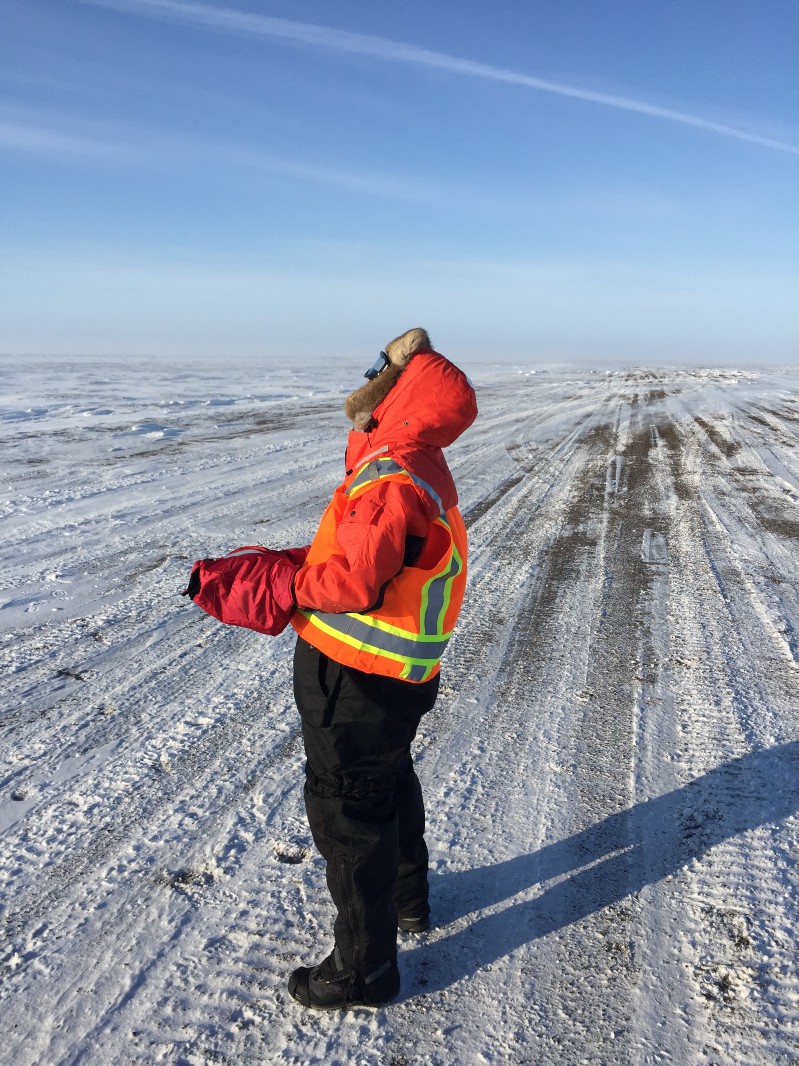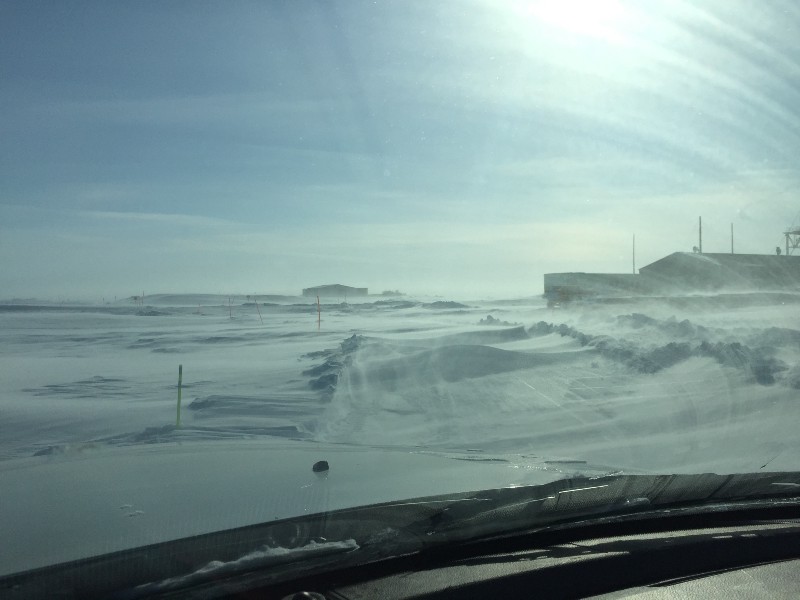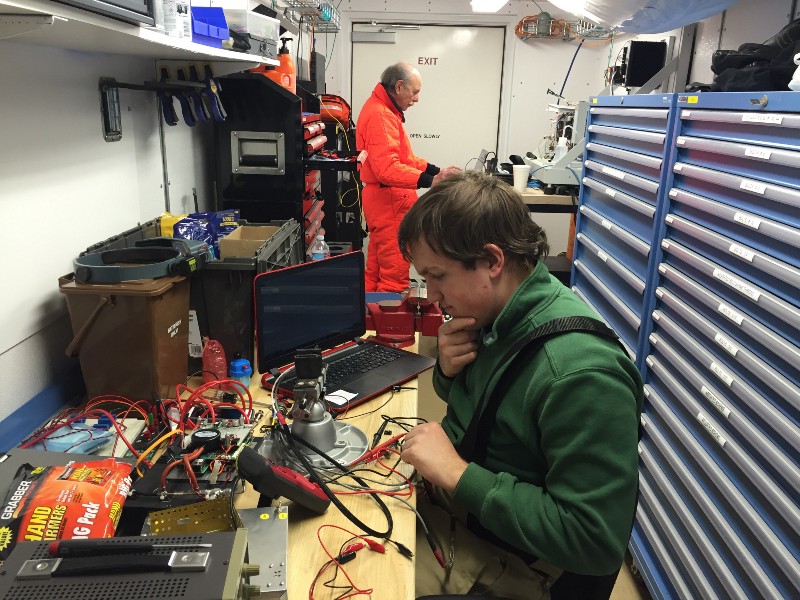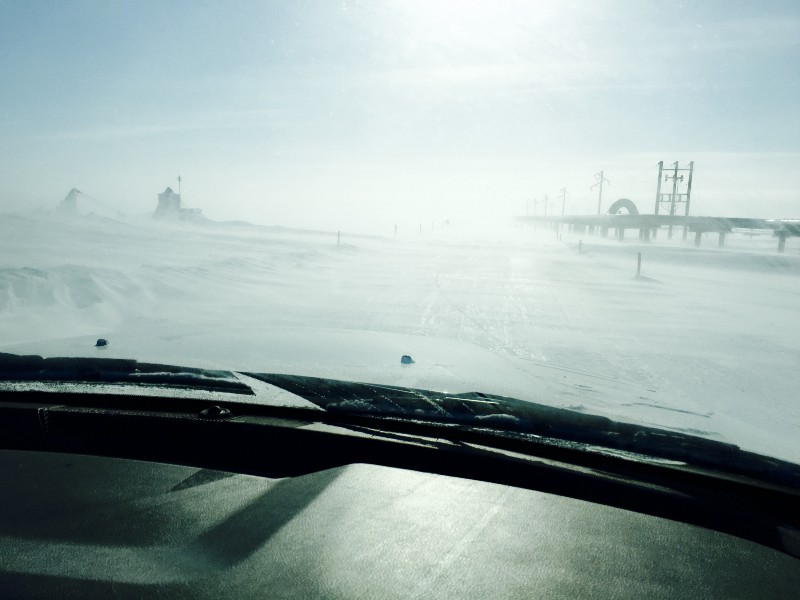
Doug piloting the DataHawk
Another interesting day at Oliktok — one day I would love to have a few of the (seemingly) boring, go-through-the-motions days that we seem to be able to reproduce readily when flying in Boulder! We decided to switch up the schedule a bit today, taking a lunch with us so that we could stay through the afternoon if necessary. Until now, we had been going back to the NOC for lunch every day (about a 5-minute drive), and during that time the site would get drifted in enough to make it challenging to return. This way, we could complete a full day of POPS sampling and hopefully some DataHawk flights to boot. That was the plan, anyway… Reality turned out a bit different.

The road to the AMF-3, when drifted in. We decided to turn around in order to avoid getting stuck. For reference, those drifts in the center are around 3–4 feet tall.
With regards to POPS, this seemed like the most straightforward item. Put stuff in the box, plug it in, turn it on, and put it up on the roof. After putting stuff into the box and turning it on, we noticed an anomaly, in that the light that should be blinking to indicate that the system is logging wasn’t. We unpacked everything, and noticed that the logger worked fine when nothing was connected, but failed to log when the large multi-sensor serial cable was connected. After a moment of panic (this logging system is critical for our Pilatus operations, should the weather ever cooperate), we called back to Colorado to talk with Gabe LoDolce, who designed and built the system. We deduced that we likely had a short somewhere in our cluster of cables, most likely where the connector plugs into the shielded logger box. Fortunately, we caught this before putting things up on the roof — had we not, there would have been a good chance that we might have ended up with an inoperable data logger. Phillip has spent the whole day going through the wiring to find where the short is — good thing he’s here!

Phillip troubleshoots one of our connectors, while Al keeps up on the logistical coordination.
Now on to the DataHawks — Yesterday I mentioned that we had an issue with radio communications. It seems as though this was the result of a recent “enhancement” to the system which increases the overall performance of the antenna system on board. This is an example of something that should work well, but encounters potential issues when deployed to the field! After bypassing this antenna diversity board, radio communications seem to have remained stable. With stable comms, we decided to get a flight or two in. In the end, I think that this was relatively successful. We completed a flight which included both manual and autopilot flying, with no communication issues. We also are very confident that we found the DataHawk’s operational limit in terms of wind speed at cruise altitude. Initially, we had set the autopilot to fly at an airspeed of 20 meters per second. Winds had been hovering in the 13–14 m/s range at the surface, with higher gusts, and the plane was struggling to make forward progress in these conditions at an altitude of around 100 meters. Therefore, we decided to go to maximum programmable airspeed (26 m/s), but when we handed the plane back to the autopilot with this setting, we observed the plane to put its nose down gently and decrease altitude. Because the plane is not capable of actually reaching 26 m/s here at sea level and in cold conditions, it changed its flight trajectory to try to achieve that airspeed. At this point, Doug tried to take control of the aircraft, but with low visibility, turbulent winds, and a pretty substantial wake behind the hangar structure, this resulted in a somewhat rough inadvertent landing out on the tundra, about 100 yards off of the runway. With Al as bear guard we recovered the aircraft and it looks to be flyable at a later date (with slightly calmer winds…).

View from the truck down the road at Oliktok Point. Visibility was limited, at best!
To add to the fun, there was a polar bear spotted out on the sea ice today. Now some of you may think this is pretty neat, but ultimately, it puts everyone on a higher state of alert and impacts the extent of our operations. As I said last summer, bears are cool but they get in the way of research!! The final icing on the cake has to do with our rental trucks, which also appear to be struggling with the cold. Both have diesel engines, and while they are running fine, both are giving us warning lights about the emissions cleaning systems with which they are equipped. This will mean a trip to Kuparuk camp (about 40 minutes away) on Sunday, when winds are expected to be howling at up to 50 mph. Never a dull moment at the interface of rocket science, climate science and the Arctic!
